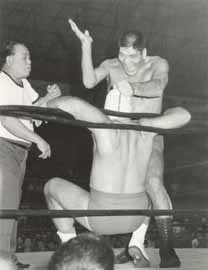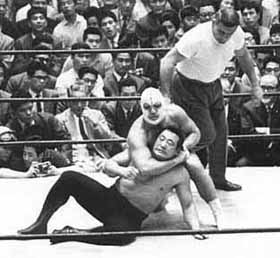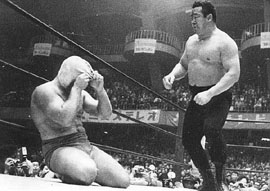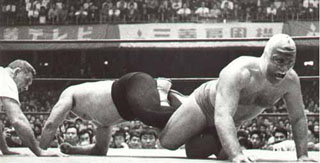The Destroyer: A Heel Gets Respect in Japan (Part I of II)
The Interview Series
The room was spinning counterclockwise. But that was fine. My eyes were closed.
"How do you even make it to the office after one of your booze sessions?" asked junior reporter Junko.
I grunted a few times and rolled over onto my back. My eyes were still closed but I knew it was her standing in my office doorway. Repetition of the same scene will do that. I also had a feeling that it was early morning.
"Don't you have any heroes to guide you away from what you've become - an unshaven, unkept alcoholic that reads girlie magazines?" she continued.
"Morning, my dear," I said, checking the left side of my face to make sure that it was indeed properly unshaven.
I moved from the floor to my desk and pulled the latest edition of Flash from my top drawer. Before peeling back the cover, I let it sit on my desktop for a few moments so Junko could get a nice long look at the incredibly large breasts on this week's cover girl.
She turned her eyes to the ceiling.
"I'm usually speechless upon first viewing each week as well," I said and turned to the retrospective feature on Akiko Wada, one of Japanese TV's most famous talents. In the middle of the photo montage covering her career was a picture of her with The Destroyer, the famous pro wrestler.
"Now, if you want heroes, that's exactly what he was to the Japanese people at one time." I tapped the page with my right index finger. "I shared a conversation with him a couple of weeks ago."
Junko moved her gaze closer to the page and slowly began to shake her head back and forth. I put my feet on my desk and pulled my ashtray close.
"I can wrestle a broomstick and make it look good," The Destroyer remembers answering to a query from his promoter, Jules Strongbow, before a 1963 match at Los Angeles' Olympic Auditorium. His promoter wanted to know whether he could wrestle a young and upcoming 6'10" wrestler from Japan by the name of Giant Baba. At this point, The Destroyer had been wrestling for eight years and knew that making weaker, younger, and less experienced opponents look like champions was a key to success in the wrestling business.
"Every time I went into the ring, I tried to make my opponent look like I was beating somebody," he says. "Because if you beat somebody and it doesn't look like you've beaten anybody then you haven't beaten anybody."
 |
| The Destroyer Making Giant Baba Look Good |
In other words, a couple of simple knockdowns made to look a little harder than they actually were could generate enough fan interest where subsequent matches involving the two opponents would be immensely popular. "Giant Baba was a very good athlete," The Destroyer emphasizes. "He was a pitcher for the Tokyo Giants prior to going into pro wrestling. You take a good athlete into the ring and you can make something [out of him]."
The Destroyer did just that. He made Giant Baba look so good in three sold out matches that when he fought Rikidozan as the WWA (World Wrestling Association) champion the next year in Japan it drew 70 million TV viewers. This would be the opening bell in a relationship with Japan that still endures to this day.
Over the course of his 39-year career that began in the US mid-west in the 1950s, The Destroyer fought nearly 8,500 matches. He faced such wrestling legends as Ilio DiPaolo, Sandor Szabo, Johnny Rubberman Walker, Gorgeous George, Cowboy Bob Ellis, Big Bill Miller, and Mil Mascaras.
Even today, eight years after his retirement, The Destroyer looks like he could still spring off the ropes and perform a few takedowns and full nelsons. Seated at a table one recent evening in the back storeroom of Tanny Enterprise Co., an electrical shop and merchandiser for The Destroyer's t-shirts, posters, and masks in Azabu-Juban, Tokyo, The Destroyer maintains an intimidating presence. He is powerfully built and oftentimes punctuates his statements with a hard pounding on the table with his fist, no doubt to compensate for the sorely missed old thump of a wrestler's back hitting the canvas in the days of yore. Then there is the mask.
"One old timer told me, 'if you get a mask, identify it so that everybody knows that's you when they see that mask.'" He did and has. His large red nose pokes through a hole in the heavy white mesh material. Three other holes are for his eyes and mouth. It is impossible to find a picture of The Destroyer without his mask; The Destroyer at dinner banquets in suit and tie, The Destroyer on a surfboard, and, of course, The Destroyer in his home - the ring.
But at one point, The Destroyer almost wasn't. In 1962, he went to San Diego to wrestle as Dick Beyer (The Destroyer's real name and, until then, his wrestling name). The promoter, Hardy Kruskamp, said he wanted a masked man to fight on a particular night. There was one problem. Dick didn't have a mask.
 |
| A Headlock On Rikidozan |
"Vic Christie, the number one jokester in the business," The Destroyer recalls, "brought in a mask made of wool with two little peep holes for the eyes. It fit down over my head and around the crotch. [Before] I always went in the ring with white shoes, shined up, nice tights, and a nice jacket as Dick Beyer. Now I am going in the ring and I look like a bum."
Begrudgingly he fought that night with the uncomfortable wool mask. But at the match's completion, he tore it off and said to the promoter, "Hardy, you've seen the first and last match of The Destroyer!" That was until another wrestler, Ox Anderson from Salt Lake City, came to the rescue.
"He threw me a mask and said, 'Try this one on. It's made out of a woman's girdle. You can buy them at Woolworth's.'" And with that The Destroyer was born, girdle mask and all.
The trim around the mask holes has been red, green, blue, and black over the years. "I was color coordinated," he says proudly. "For example, if I wore green tights, I wore a green mask and green socks. But I always wore white shoes."
Rikidozan, Japan's first post-Occupation wrestling hero, would later meet those white shoes on a day in 1963, face to foot.
Post-Occupation wrestling matches in Japan, like matches of the same period in the US, typically touted a "baby face" against a "heel." This was to develop an immediate love for one wrestler and a simultaneous hate for the other. Such opposing feelings for different wrestlers was considered equally important by promoters interested in forging reputations and establishing fan enthusiasm for subsequent matches. In most cases, the heel would enter the ring and showcase a number of illegal and dirty moves; the pulling of hair and tights, punching, and kicking. The baby face, in the end, would triumph through a display of superior skill and technique.
In the US, generating a heel necessitated an imposing name, like "Ox," "Killer," or "Big," or a frightening mask. In post-Occupation Japan, finding a heel was as simple as finding an American. If he were large and strong, all the better. The baby face was, of course, Japanese.
 |
| Rikidozan Closes In |
The effect of the baby face victories over the American heels on the Japanese populace was immeasurable. Robert Whiting, in his recent book Tokyo Underworld, describes Japan's reaction to Rikidozan's first victory in a tag team match over a pair of American brothers in 1954 as: "It was as if the Pacific War had just been re-fought - and, this time, won. Overnight, Japan had a new national hero."
This national hero would take center stage in a bout on May 24, 1963 with a new heel from the US, The Destroyer, at the Tokyo Municipal Gymnasium in Sendagaya, Tokyo. The match would become the most viewed commercial TV show in Japanese history and mean a $3,000 payoff to The Destroyer, his single biggest ever. But in the ten years prior to this bout, there had been hundreds of matches featuring Japanese baby faces and American heels, why was this one so big?
The Destroyer's prior fights in LA with Giant Baba was one of the reasons. But the other key was The Destroyer's victory in LA in 1962 over Freddie Blassie to give him the WWA title. Blassie wrestled in Japan in 1961 and was infamous for filing his teeth. "Four Japanese television viewers died [of heart failure] watching him bite Rikidozan," The Destroyer says. "Blassie wrestling Rikodozan [in 1961], my beating Blassie [for the WWA title], and my 3 bouts [with Giant Baba] in LA was what made the match so big."
The stage was set the night before when Killer Kowalski, an American, opposed Rikidozan at the same venue. It was the finals of what was called the World League. With a nice suit and tie on, The Destroyer jumped into the ring prior to the match's beginning and went directly to Rikidozan. The Japanese fans expected him to provide a prelude to what was to follow the next night - the mannerisms of an annoying and antagonizing wrestler, or a heel. But he didn't.
"I went over to Rikodozan, looked him straight in the eye, shook hands with him and gave him a little bow. Then I went over to Kowalski and he started pointing and imitating the handshake [with Rikidozan]." The Destroyer then slapped Kowalski's face. To this day people in Japan come up to him and say, "I remember when you slapped Kowalski!"
Like Kowalski, Blassie, and dozens of other American wrestlers before him in Japan, The Destroyer was supposed to fill the role of the heel in his match against Rikidozan. "Normally in the States," he explains, "they cheer the baby face and boo the heel. Well, [on that night] I didn't get any boos. I learned then that these people like wrestling." Or at least he learned that Japanese folks like Americans that slap other Americans in the face.
"So I gave them wrestling," he says of the fight. "I didn't punch. I didn't kick. I gave them headlocks, arm drags, etc." He even featured his trademark hold - the figure-four-leg-lock. This complex hold involves pinning your opponent to the canvass with your legs in the shape of a "4."
 |
| The Figure-Four-Leg-Lock |
"I got that [the figure-four-leg-lock] on him and we kind of rolled out of the ring and then back in." Throughout his career The Destroyer offered a thousand dollars to any wrestler that could break that hold. Rikidozan didn't collect and neither did anyone else.
It was a best of three-fall match over the course of an hour in front of a full house and a dozen sportswriters. The first fall went to the Destroyer. "I used a suplex on him," The Destroyer recalls of his one fall. A suplex involves taking a wrestler over backwards and dumping him back on his head. "He had a headlock on me and I brought him back in a suplex and covered him one, two, three."
Rikidozan was a former sumo wrestler and The Destroyer credits this training for Rikidozan's "incredible balance." But, The Destroyer acknowledges, Rikidozan's strongest weapons had nothing to do with sumo. "He used a lot of chops and he kicked."
The Destroyer would witness this chopping ability in the next fall of the match. "He threw me off a headlock I had on him and I hit the ropes. As I came back, he sidestepped me and chopped me pretty good, knocking out one of my front teeth. He stunned me and covered me off that."
Other exchanges were just as intense. "One time, he kicked me and left lace marks on me." The Destroyer then turned to the referee, Fred Atkins, and exclaimed, "That son-of-a-bitch!"
The referee recommended that he kick him back. The Destroyer did exactly that, lacing him with his white shoes across the face. Rikidozan became so incensed that he spouted the few words of English he knew, or so says The Destroyer, "Cock-sucker-son-of-a-bitch!"
The match and the cursing would play to a draw. The Destroyer's legend, however, was just beginning.
Coming next week: The Destroyer recalls his last days with Rikidozan and his subsequent fights in Japan. Note: all wrestling pictures provided by The Destroyer.

